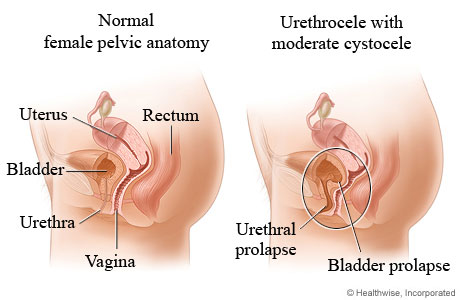Urethral prolapse (urethrocele)

The urethra is the tube that carries urine from the bladder to the outside of the body. When the muscles and tissues that hold the urethra in place get weak or damaged, the urethra can move from its normal position and press against the front wall of the vagina. This is called a urethral prolapse (urethrocele).
It is common for a bladder prolapse (cystocele) to develop along with a urethral prolapse. Both kinds of prolapse can press against the front wall of the vagina. This is also called anterior vaginal wall prolapse.
How can you care for a urethrocele?
- Do not do activities that put pressure on your pelvic muscles. This includes heavy lifting and straining.
- Try exercises to tighten and strengthen your pelvic muscles. These are called Kegel exercises. (If doing these exercises causes pain, stop doing them and talk with your doctor.) To do them:
- Squeeze your muscles as if you were trying not to pass gas. Or squeeze your muscles as if you were stopping the flow of urine. Your belly, legs, and buttocks shouldn't move.
- Hold the squeeze for 3 seconds, then relax for 5 to 10 seconds.
- Start with 3 seconds, then add 1 second each week until you are able to squeeze for 10 seconds.
- Repeat the exercise 10 times a session. Do 3 to 8 sessions a day.
- Talk with your doctor about a vaginal pessary. This is a device that you put in your vagina to support the urethra. Your doctor can teach you how and when to remove it. You will also learn how to clean it and put it back in.
- If your doctor prescribes vaginal estrogen cream, use it exactly as prescribed.
©2011-2025 Healthwise, Incorporated
The content above contains general health information provided by Healthwise, Incorporated, and reviewed by its medical experts. This content should not replace the advice of your healthcare provider. Not all treatments or services described are offered as services by us. For recommended treatments, please consult your healthcare provider.
